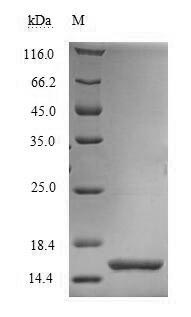This recombinant Drosophila melanogaster Partner of bursicon protein is produced in a yeast expression system, which appears to provide high fidelity to the native form. The protein comes with an N-terminal 6xHis tag that makes purification and detection more straightforward. The product spans the full length of the mature protein—specifically amino acids 21 to 141—and reaches a purity of greater than 90% as determined by SDS-PAGE. It's intended for research use only.
The Partner of the bursicon protein plays what seems to be a critical role in the post-molt hardening of the exoskeleton in Drosophila melanogaster. It works as a neuropeptide hormone, forming a heterodimer with bursicon, and appears to be involved in regulating cuticle sclerotization and wing expansion. This protein may prove pivotal in studies related to insect development and molting processes, potentially offering insights into endocrine signaling pathways.
Potential Applications
Note: The applications listed below are based on what we know about this protein's biological functions, published research, and experience from experts in the field. However, we haven't fully tested all of these applications ourselves yet. We'd recommend running some preliminary tests first to make sure they work for your specific research goals.
The recombinant Drosophila melanogaster Partner of bursicon (pburs, 21–141aa) expressed in yeast with an N-terminal 6×His tag represents the full-length mature protein, and yeast is generally capable of supporting correct folding and disulfide bond formation for small secreted proteins like pburs, which belongs to the cystine knot hormone family. However, pburs functions as a heterodimer with bursicon, and its biological activity depends on correct pairing with bursicon and proper cystine knot folding. While yeast can form disulfide bonds, it cannot guarantee proper folding or dimerization without co-expression of the bursicon partner. Therefore, this recombinant pburs is likely folded correctly as a monomer but unlikely to be biologically active in its natural functional form unless co-expressed or reconstituted with bursicon.
1. Protein-Protein Interaction Studies
This recombinant pburs protein can be used to study binding interactions between pburs and bursicon or other potential partners in Drosophila. The N-terminal 6×His tag allows immobilization for pull-down or co-immunoprecipitation assays. If the protein maintains correct folding, it may bind bursicon or other interacting proteins with native-like affinity. If misfolded or lacking its heterodimer partner, it can still serve as a screening tool for identifying possible interactions, but may not accurately reflect physiological binding. Therefore, functional verification through bursicon co-binding or ligand assays is recommended before interpreting binding results.
2. Antibody Development and Validation
This purified recombinant pburs protein is suitable for generating specific antibodies recognizing pburs. The >90% purity ensures consistent immunogenicity. If correctly folded, it will generate antibodies capable of recognizing native pburs conformations in Drosophila tissues. If misfolded, it will still be an effective linear-epitope immunogen, suitable for Western blot or ELISA applications. Thus, it is a reliable antigen for antibody production, though native binding validation should be done if the antibodies are intended for immunostaining or functional studies.
3. Biochemical Characterization and Structural Studies
The recombinant pburs protein can be used for biochemical characterization, such as determining molecular weight, stability, and secondary structure using circular dichroism or size exclusion chromatography. If folded correctly, it may provide insight into the cystine knot domain architecture and could be used for crystallography or NMR if monodisperse. If not properly folded, it remains useful for low-resolution biophysical profiling but not for detailed structural or functional analysis. The absence of its bursicon partner should be noted, as pburs forms a functional heterodimer in vivo.
Final Recommendation & Action Plan
The recombinant Drosophila pburs is likely to be properly folded as a monomeric cystine knot protein, but not biologically active on its own, as its functional role requires dimerization with bursicon. It is well-suited for antibody development, biochemical characterization, and interaction screening, but not for functional or receptor activation assays unless reconstituted with bursicon.






